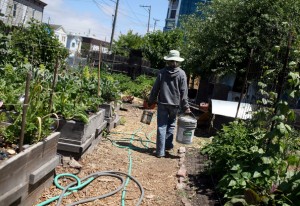California's farming revolution: a glimpse into the future of food policy

California's agricultural population is beginning to show its age. As the average age of farmers in the Golden State edges toward 60, the California Department of Food and Agriculture is reaching out to young people, while advocating a more sustainable, local-food-driven model to expand California's $37.5 billion a year agricultural industry and incorporate a new wave of beginner agriculturalists.
The stakes are high for the global economy, say some experts. We've been told that by 2050, farmers will have to double their current output to keep pace with 2 billion new eaters. California does its part by providing 12 percent of the nation's agricultural exports. In fact, according to the San Francisco Chronicle, state agriculture secretary Karen Ross called California agriculturists “leaders” in this charge. As leaders of an industry that employs 800,000 people statewide, it is essential that the average age of primary farm operators, which now stands at 58, reverses its trend Ross says.
After reading the first few paragraphs of Stacy Finz's Chronicle piece, “California's young farmers break traditional molds,” it's easy to slip into despair. How can we possibly stay food secure with an aging farm population and no one willing to inherit the work? Well, when you read a little further, it would appear that the only ones who should be fretting are the Big Ag corporations who have, up until recently, thought the field was clear of small-scale competition.
It seems like the incentives that industrialized society started marketing to young people four decades ago – to leave the land and seek fortune and security in the city – are losing their appeal. And the generations who saw their prime in the 70's, many of whom abandoned the plow for the cubicle, are seeing their children come full circle, embracing the more sustainable and smaller-scale operations of their grandparents' day.
The ag secretary shared some telling figures, which serve as evidence of an agricultural renaissance. She said that last year, a record 70,000 students enrolled in their high school Future Farmers of America Program, and that the majority of new interest in farming is from people who don't come from farming families.
That isn't to say the small-scale, family farming revolution is a completely youth-driven affair:
"There are lots of people starting whole different lives in their 50s," Ross said. "And for a lot of the new farmers in California, this is a second career. Some of these people can be very successful. While they may not know much about farming, they are seasoned in life and make really good business people."
The collective yearning by new agriculturalists to 'start over' puts California in a good position. The Golden State offers advantages to this burgeoning new crop of farmers that other states can't.
“Unlike other states, where future generations are expected to take over the land and outsiders aren't always welcome, the agriculture community here has more tolerance for change and few preconceived notions,” writes Finz.
Now, let's keep all of this in its proper context. What we are experiencing isn't so much a movement back to the land as it is a revolution of American production agriculture on the whole. Entrepreneurs are installing mini-farms on rooftops in urban areas and market gardens in back (and front) yards across the country. Vacant city lots are more and more being employed as community gardens, with plots available for any resident to rent. Many suburban residents are combining their capital to lease land, and organize community-supported agriculture programs (CSAs) – where shares of farm produce are sold directly to the public, cutting out expensive corporate middlemen like packers, distributors and grocers. In short, demand for local food is booming and so is production.
"Farmers of the future won't necessarily be just in the (rural areas). We need big and large to sustain the world's need for food," says Ross.




